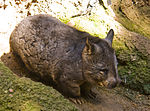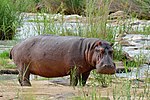Hindgut fermentation is a digestive process seen in monogastric herbivores (animals with a simple, single-chambered stomach). Cellulose is digested with... 10 KB (1,137 words) - 09:04, 17 February 2024 |
 | as opposed to other atlantogenates that rely on the more typical hindgut fermentation, though this is not entirely certain. Ruminants represent the most... 39 KB (3,950 words) - 01:55, 23 April 2024 |
cellulose by microbial fermentation. Monogastric herbivores which can digest cellulose nearly as well as ruminants are called hindgut fermenters, while ruminants... 4 KB (382 words) - 21:35, 18 January 2024 |
colobine monkeys and in sloths. Ruminant foregut fermentation Hindgut fermentation Enteric fermentation Munn, Adam J.; Snelling, Edward P.; Taggart, David... 1 KB (141 words) - 17:28, 6 February 2024 |
 | are a foregut fermenters (as opposed to the pigs' hindgut fermentation) This foregut fermentation, similar to but separately evolved from a ruminant... 26 KB (2,802 words) - 05:46, 29 April 2024 |
 | levels of cellulose in their plant based diet, manatees utilize hindgut fermentation to help with the digestion process. Manatees have been known to eat... 61 KB (6,412 words) - 14:01, 26 April 2024 |
 | a major component of grass, through the process of hindgut fermentation. Cellulose fermentation by symbiotic bacteria and other microbes occurs in the... 140 KB (14,896 words) - 12:15, 26 April 2024 |
primates can derive significant amounts of phytanic acid from the hindgut fermentation of plant materials. Global DARE Foundation (Patient Advocacy Group... 13 KB (1,342 words) - 03:39, 3 December 2023 |
 | the moist ones are typically eaten by the animal (coprophagy or hindgut fermentation). These moist pellets contain large amounts of nutrients that were... 9 KB (1,043 words) - 16:12, 28 October 2023 |
non-human primates can derive significant amounts of phytol from the hindgut fermentation of plant materials. Phytol and/or its metabolites have been reported... 14 KB (1,404 words) - 11:18, 26 October 2023 |
orangutans), can derive significant amounts of phytanic acid from the hindgut fermentation of plant materials. Freshwater sponges contain terpenoid acids such... 10 KB (947 words) - 01:02, 15 April 2024 |
Anaerobic organism (section Fermentation) propionic acid fermentation, butyric acid fermentation, solvent fermentation, mixed acid fermentation, butanediol fermentation, Stickland fermentation, acetogenesis... 23 KB (2,493 words) - 15:16, 5 February 2024 |
pseudoruminants may use foregut fermentation to break down cellulose in fibrous plant species (while most others are hindgut fermenters with a large cecum)... 2 KB (145 words) - 01:17, 30 July 2023 |
 | dry environments such as Minotaurasaurus may have relied more on hindgut fermentation for digestion or, alternatively, consumed succulent plants that did... 31 KB (3,360 words) - 16:40, 2 March 2024 |
 | the species also is unique in possessing a digestive system capable of fermentation and the effective breaking-down of plant matter, a trait more commonly... 28 KB (3,104 words) - 15:21, 5 April 2024 |
information also relates to all animals that eat cecotropes. These animals are hindgut fermenters. This means fibrous food material is fermented after the small... 23 KB (2,604 words) - 14:39, 10 April 2024 |
 | gallbladder). The tract may also be divided into foregut, midgut, and hindgut, reflecting the embryological origin of each segment. The whole human GI... 49 KB (5,781 words) - 08:06, 17 April 2024 |













